The MGA With An Attitude
Accelerator PEDAL POSITION - CB-114
At 11:14 AM 7/2/2009 -0600, Bill in NC wrote:
>My accelerator pedal places my foot in a very uncomfortable position, almost bent backward. Can this be fixed by adjusting the pedal to give a more comfortable driving position"?
It might be adjusted a little, but not much. Start with this picture of the later model left hand drive throttle pedal assembly. At lower left there is an adjustable pedal stop on the floor under the pedal arm. At upper left there is a rubber upper pedal stop on the fixed bracket. At right is the pedal return spring and fixing bracket and modified trunnion that was introduced in mid 1500 production. (Click for larger image).
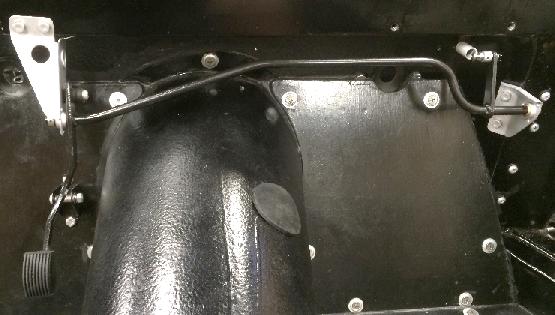
The supplementary return spring attached to the throttle arm (along with associated bulkhead bracket and change of trunnion) was used commencing with car number 24594. Illustrations taken from the Service Parts Lists (click for larger images) are not entirely correct, but 1600 shows the correct spring bracket, and Twin Cam shows the correct trunnion with extended outboard end to accept the spring. It is recommended that these parts should be retrofit to earlier cars.
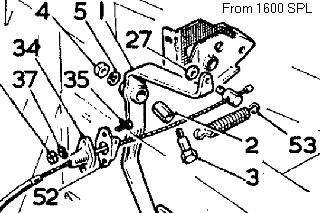
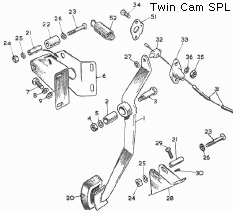
More pictures of the rubber sleeve on the upper pedal stop.
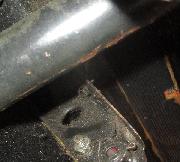
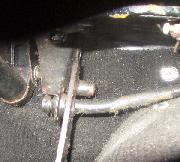
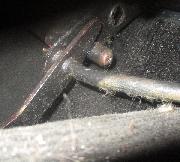
Left side  Face on Face on  Right side Right side
On 24 Nov 2017, JL Cheatham in Virginia, USA wrote:
"There are 6 pieces in the stop assembly. One screw 1/4"-28 x 1-3/8" Pozidriv pan head (1-1/2" will work). One 1/4" flat washer. One distance piece 3/4" long with a rubber sleeve. One lock washer and one 1/4-28 nut".
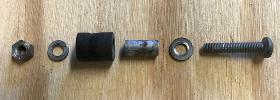
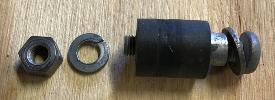
That "Pozidriv" screw may be wrong. The Service Parts Lists for MGA call for PMZ0422 Screw (1/4-28-UNF x 1-3/8 long Phillips slot). If you leave out the "0" you get a part number for a Pozidriv screw, like this: PMZ0422 Screw (1/4-28-UNF x 1-3/8 long Pozidriv)
The normal setup is to set the engine idle speed first, so the rest position of the idle arms is correct before you fiddle with the cable. Then pull the cable all the way out at the carb end, and attach it to the throttle arm with minimum slack in the cable This makes the pedal all the way up, high as it can go, with the pedal output arm above right side passenger's feet close to the bulkhead. Then remove air cleaners and block the air floats up so you can observe the throttle plates. Have a friend press the pedal down with fingers only until the throttle plates are wide open and hit the open stops. The plates should then be horizontal, edge on to the air flow for minimal restriction of the inlet air flow.
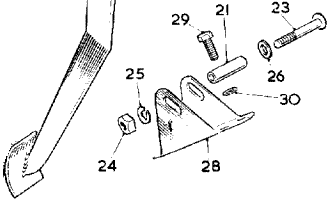
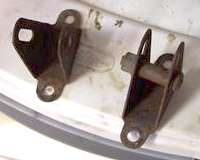
Look at the pedal in this position. It should be a little short of hitting the floor. There should be an adjustable pedal stop on the floor underneath the pedal. Loosen the bolt and bring the stop up against the bottom of the pedal when the throttle is full open,
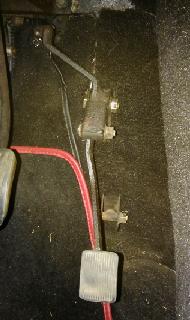 and tighten the bolt in that position. The pedal stop keeps the driver from mashing the pedal too far down and stretching the cable or breaking something with too much force. Photo at right shows the accelerator pedal from a right hand drive car. The upper travel stop is a rubber sleeve on the lower bolt of the pivot bracket.
and tighten the bolt in that position. The pedal stop keeps the driver from mashing the pedal too far down and stretching the cable or breaking something with too much force. Photo at right shows the accelerator pedal from a right hand drive car. The upper travel stop is a rubber sleeve on the lower bolt of the pivot bracket.
Normally that's all you do to adjust the pedal, so the upper limit is generally as high as it can go. However, you can tinker a little. You could add a piece of heater hose to increase diameter of the rubber upper stop (and maybe a larger flat washer to retain it), thereby restricting the pedal for a bit less upward travel (making the pedal rest position a bit lower). Then repeat adjustment of the lower pedal stop as noted above, and you can end up with the pedal a little closer to the floor.
The only way to get full throttle operation with less pedal travel is to increase the mechanical lever ratio of the pedal to make the cable travel farther. That would be a bit of a challenge. It might be easier to make a slightly shorter throttle arm for the carburetor shaft. As usual, if you do anything non-standard on the car you should document it so the next person to lay hands on it (maybe even yourself later) will not be confused.
|